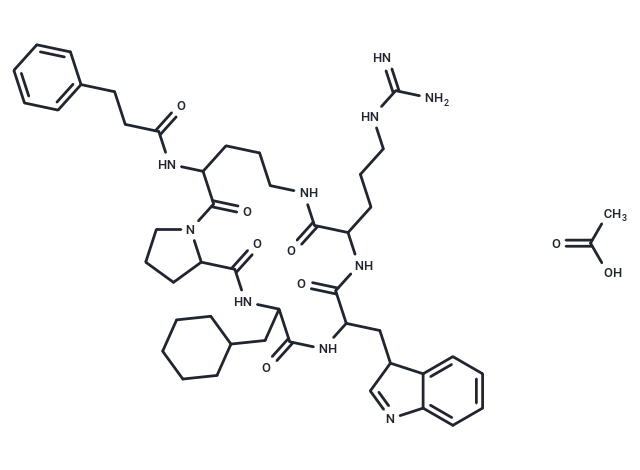Shopping Cart
- Remove All
 Your shopping cart is currently empty
Your shopping cart is currently empty

PMX 205 acetate is an antagonist of complement C5a receptor (C5aR; CD88).

| Pack Size | Price | Availability | Quantity |
|---|---|---|---|
| 1 mg | $113 | In Stock | |
| 5 mg | $296 | In Stock | |
| 10 mg | $389 | In Stock | |
| 25 mg | $827 | In Stock | |
| 50 mg | $1,320 | In Stock | |
| 100 mg | $1,928 | In Stock | |
| 1 mL x 10 mM (in DMSO) | $415 | In Stock |
| Description | PMX 205 acetate is an antagonist of complement C5a receptor (C5aR; CD88). |
| In vitro | PMX 205 (PMX205) group is in between 0.09893 to 0.2465, EP54 group, 0.02724 to 0.1748 and Tamoxifen group, the value recorded in between 0.09880 to 0.2464. For the 48 h plate of incubation time, only two groups of PMX 205 and Tamoxifen show a significant result. The values recorded are in between 0.04987 to 0.3273 and 0.5777 to 0.8551 respectively. For the 72 h plate, only one group shows a significant result, PMX 205 (antagonist group) with the value recorded in between 0.02136 to 0.5322[1]. |
| In vivo | Tg2576 mice are treated with PMX 205 (PMX205) at 20 μg/mL in the drinking water (n=17) from 12 to 15 mo of age, the time frame at which there is a rapid accumulation of amyloid deposits in these animals. Untreated Tg2576 animals (n=11) are used as controls. After 3 mo, animals treated with PMX 205 show significantly less fibrillar plaque load (thioflavine reactivity) than do untreated animals. In 3×Tg mice, PMX 205 also significantly reduces hyperphosphorylated tau (69%)[2]. |
| Molecular Weight | 899.09 |
| Formula | C47H66N10O8 |
| Smiles | NC(NCCCC1NC(C(NC(C(NC(C2CCCN2C(C(NC(CCC3=CC=CC=C3)=O)CCCNC1=O)=O)=O)CC4CCCCC4)=O)CC5C=NC6=CC=CC=C56)=O)=N.CC(O)=O |
| Relative Density. | no data available |
| Storage | keep away from moisture | Powder: -20°C for 3 years | In solvent: -80°C for 1 year | Shipping with blue ice. | ||||||||||||||||||||||||||||||
| Solubility Information | DMSO: 60 mg/mL (66.73 mM), Sonication is recommended. | ||||||||||||||||||||||||||||||
Solution Preparation Table | |||||||||||||||||||||||||||||||
DMSO
| |||||||||||||||||||||||||||||||

Copyright © 2015-2025 TargetMol Chemicals Inc. All Rights Reserved.